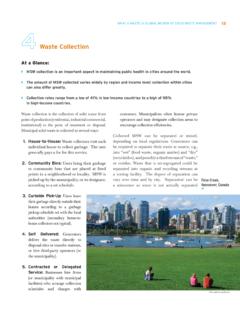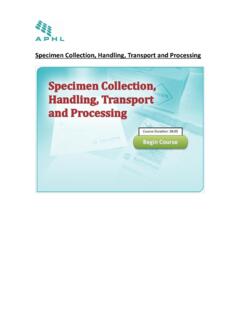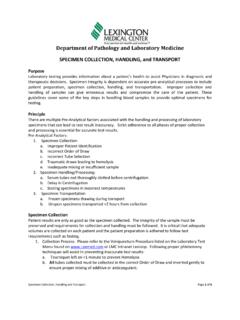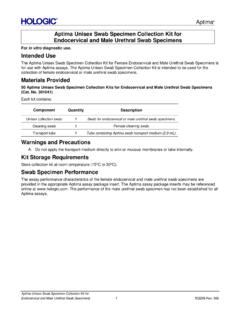Transcription of Example of writing up Data Collection Procedure 3.3 Data ...
1 Example of writing up data Collection Procedure data Collection In order to achieve the research s objectives for this study both primary and secondary data will be collected. Primary data speaks to the range of Collection tools such as interviews and questionnaires that are used to gather first-hand data whereas secondary data speaks to data or sources that already exist. This would further be detailed below. Questionnaire A questionnaire will be used to obtain primary data from participants at the institution. In so doing, the researcher will be able to evaluate the current level of brand equity the institution (objective 2).
2 In order for the researcher to collect data to build and generalise a theory the researcher will administer a questionnaire to a sample of one hundred (100) participants. The researcher will utilize a non-probability sampling technique namely convenience sampling since the data sources for the researcher is within reach relative to the cost of locating participants and the geographic distribution of participants (Larvakas, 2008) . The questionnaire will be distributed via email where a link will be provided to complete the questionnaire. It will consist of both opened and closed ended questions.
3 The researcher will make use of Aaker (1996) Brand Equity Dimensions, that is, brand awareness, brand image, brand preference and brand loyalty as the basis for designing the questionnaire. The intention is to develop each of these latent variables into a scale by using three (3) Likert scale questions to provide content validity of each latent variable. The scale for each question would be based on a five (5) point Likert scale of agreement, where 1 represents strongly disagree and 5 represents strongly agree. This approach to the questionnaire was inspired by and is consistent with the procedures described by Kim & Ko (2012).
4 Interviews The rationale behind choosing interviews to collect data according to many researchers is that interviews are one of the methods that are best used to answer research questions (Alshenqeeti, 2014). Therefore, the researcher will employ interviews in particular unstructured face to face interviews with the three (3) marketing officers and the marketing manager in order to gain a comprehensive understanding of the current SMM strategies employed at the institution (objective 1). In addition, the interviews will also be used to analyse the current measures of performance for each strategy (Creswell, 2013).
5 Therefore, the interview questions will be derived from the SOSTAC model proposed by Chaffey (2014) which describes the key elements of a SMM strategy including situational analysis, objective setting, strategy and tactics for reach, interaction and engagement. The researcher will meet once with the interviewees at an agreed day, time and location within the institution for 30 minutes. Telephone interviews will only be conducted if the participants are unable to meet face to face. Various researchers highlighted the convenience and cost effectiveness of telephone interviews (Cooper & Schindler 2008; Qu & Dumay 2011) In order for the researcher to prepare for interviews a participant information sheet will be provided to each participant to inform them about the research so that they can prepare their responses.
6 According to Farooq (2015) the researcher will build rapport with the interviewees as well as ensure that the interview environment is comfortable and relaxing. The researcher will get permissions to record the interview so that the research can be valid and credible (Brown, 2016) furthermore, the researcher will inform the interviewees of their rights. Summary of data Collection Objective Who/Where? Source data Needed Themes/Constructs How will the data be collected? Method 1. To critically analyse the current SMM strategies employed at the institution Marketing department Marketing officers (3) Marketing manager data needed will include the current SMM strategies employed at the institution Key elements from SOSTAC model will be used: Situation analysis Objectives Strategy- target market, OVP Tactics Action Control Face to Face Interview 2.
7 To evaluate the current level of brand equity from student perspective Source of data will come from students at the institution data needed will include the current perception of the institutions brand using Aaker (1996) dimensions: Brand awareness Brand image Brand Preference Brand loyalty Questionnaire 100 participants Convenience sampling Likert scale 5 point Sent via email 3. To evaluate the gaps in the current SMM strategy Source of data will come from objective 1 and 2. Results and findings from objectives 1 and 2 Literature Review The author will engage in a comparative analysis, analytical induction and benchmarking using literature and best practice Quantitative Analysis Process Wilson (2014, pg.)
8 322) Statistical Methods/Techniques Wilson (2014, ) 7KH SKHQRPHQRORJLFDO UHSRUW HQGV ZLWK WKH UHDGHU XQGHUVWDQGLQJ EHWWHU WKH HVVHQWLDO LQYDULDQW VWUXFWXUH RU HVVHQFH RI WKH H[SHULHQFH UHFRJQL]LQJ WKDW D VLQJOH XQLI\LQJ PHDQLQJ RI WKH H[SHULHQFH H[LVWV Example using phenomenology Parsons, K. (1997). The male experience of caregiving for a family member with Alzheimer's disease. Qualitative Health Research, 7(3), 391-407. 0 HWKRGRORJ\ S ,Q NHHSLQJ ZLWK RQH RI WKH LGHQWLILHG QHHGV LQ FDUHJLYLQJ UHVHDUFK WR KHDU IURP HYHQ PRUH RI WKH SDUWLFLSDWLQJ YRLFHV WKDQ ZH FXUUHQWO\ GR DQG WR WXUQ GLUHFWO\ WR OLYHG H[SHULHQFH DQG WKH UHODWHG DQG GLYHUVH VLWXDWLRQV DQG ZRUNLQJ ORFDO GLVFRXUVHV RI FDUHJLYLQJ WKH UHVHDUFKHU XVHG WKH SKHQRPHQRORJLFDO PHWKRG DV GHVFULEHG E\ 9DQ 0 DQHQ 7KH DLP RI SKHQRPHQRORJ\ LV WR H[SOLFDWH WKH PHDQLQJ RI KXPDQ SKHQRPHQD DQG WR XQGHUVWDQG WKH OLYHG VWUXFWXUHV RI PHDQLQJV RI HYHU\GD\ H[SHULHQFH *RLQJ EH\RQG WKH DFWXDO VWDWH RI DIIDLUV VXFK DV WKH KRZ ZKHUH ZKDW ZKHQ RU ZK\]]]]]
9 VRPHWKLQJ KDSSHQHG SKHQRPHQRORJ\ LV FRQFHUQHG ZLWK WKH HVVHQFH RU QDWXUH RI WKH OLYHG H[SHULHQFH IRU D SDUWLFXODU LQGLYLGXDO ,W LV FRQFHUQHG ZLWK LQWHUSUHWLQJ WKH PHDQLQJ RI WKH OLYHG H[SHULHQFH RXU OLIHZRUOG 9DQ 0 DQHQ S 'DWD DQDO\VLV S )ROORZLQJ WKH FRPSOHWLRQ RI HDFK LQWHUYLHZ WKH UHVHDUFKHU WUDQVFULEHG WKH WDSHV 7 KLV WUDQVFULSWLRQ SURFHVV KHOSHG LPPHUVH WKH UHVHDUFKHU LQ WKH GDWD DQG KHOSHG WKH UHVHDUFKHU WR WKLQN DERXW ZKDW WKH LQWHUYLHZHHV ZHUH VD\LQJ DQG KRZ WKH\ ZHUH VD\LQJ LW (DFK ZULWWHQ WUDQVFULSW ZDV UHDG VHYHUDO WLPHV ZKLOH OLVWHQLQJ WR WKH FRUUHVSRQGLQJ DXGLR WDSH WR HQVXUH DFFXUDF\ RI WKH WUDQVFULEHG WDSH DQG WR FRPH WR D EHWWHU RYHUDOO XQGHUVWDQGLQJ RI HDFK SDUWLFLSDQW V H[SHULHQFH 7 KLV SURFHVV RI WUDQVFULELQJ DQG OLVWHQLQJ DOVR SURPSWHG DGGLWLRQDO TXHVWLRQV IRU D VXEVHTXHQW]]]
10 LQWHUYLHZ 7KH VSHFLILF DSSURDFK XVHG WR XQFRYHU WKH WKHPDWLF DVSHFWV RI WKH FDUHJLYLQJ H[SHULHQFH ZDV WKH VHOHFWLYH RU KLJKOLJKWLQJ DSSURDFK RXWOLQHG E\ 9DQ 0 DQHQ ,Q WKH VHOHFWLYH UHDGLQJ DSSURDFK WKH WH[W ZDV UHDG VHYHUDO WLPHV DQG VWDWHPHQWV WKDW DSSHDU WR EH UHYHDOLQJ DERXW WKH SKHQRPHQRQ ZHUH XQGHUOLQHG RU KLJKOLJKWHG 7 KHPHV ZHUH LGHQWLILHG E\ KLJKOLJKWLQJ PDWHULDO LQ WKH LQWHUYLHZ WH[W WKDW VSRNH WR HDFK PDQ V H[SHULHQFH 1H[W WKH UHVHDUFKHU VHOHFWHG HDFK RI WKHVH KLJKOLJKWHG SKUDVHV RU VHQWHQFHV DQG WULHG WR FDSWXUH DV IXOO\ DV SRVVLEOH ZKDW PHDQLQJ WKH KLJKOLJKWHG PDWHULDO FRQYH\HG )]]]]]






